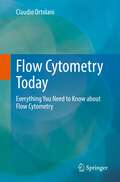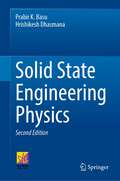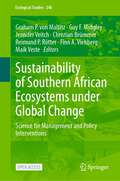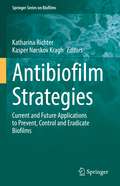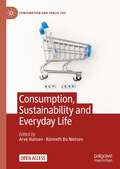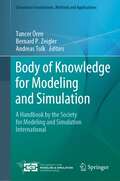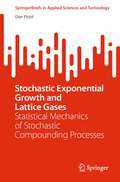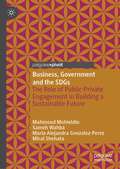- Table View
- List View
The Ocean and Us
by Farah ObaidullahThe Ocean and Us provides an overview of our contemporary understanding of the ocean and all the ways our lives interact with it. It is intended for everyone with an interest in our blue planet. The book brings together the expertise of over 35 ocean specialists from around the world. It explores a wide variety of themes including the importance of a healthy ocean in the fight to halt and contain climate change. It covers issues such as overfishing and pollution, as well as emerging themes such as the blue economy, marine animal welfare and how we can leverage innovation to protect the ocean. The book provides an overview of some of the world’s iconic threatened and at risk ocean ecosystems, and outlines current governance structures and ocean management tools. It also discusses the important social dimensions between people and the ocean, such as ocean and human wellbeing, communities and the ocean, and who gets to participate in the ocean space. The book aims to enhance ocean literacy by making specialist concepts accessible to non-experts, with a view to empowering concerned citizens everywhere to come into action for the ocean, and pave a better way forward for humanity.
Optical Nonlinearities in Nanostructured Systems (Springer Tracts in Modern Physics #287)
by Carlos Torres-Torres Geselle García-BeltránThis book provides readers with a detailed overview of second- and third-order nonlinearities in various nanostructures, as well as their potential applications. Interest in the field of nonlinear optics has grown exponentially in recent years and, as a result, there is increasing research on novel nonlinear phenomena and the development of nonlinear photonic devices. Thus, such a book serves as a comprehensive guide for researchers in the field and those seeking to become familiar with it.This text focuses on the nonlinear properties of nanostructured systems that arise as a result of optical wave mixing. The authors present a review of nonlinear optical processes on the nanoscale and provide theoretical descriptions for second and third-order optical nonlinearities in nanostructures such as carbon allotropes, metallic nanostructures, semiconductors, nanocrystals, and complex geometries. Here, the characterization and potential applications of these nanomaterials are also discussed. The factors that determine the nonlinear susceptibility in these systems are identified as well as the influence of physical mechanisms emerging from resonance and off-resonance excitations. In addition, the authors detail the effects driven by important phenomena such as quantum confinement, localized surface plasmon resonance, Fano resonances, bound states, and the Purcell effect on specific nanostructured systems. Readers are provided with a groundwork for future research as well as new perspectives in this growing field.
Flow Cytometry Today: Everything You Need to Know about Flow Cytometry
by Claudio OrtolaniThis book covers all the technical aspects of flow cytometry needed to set-up the instrument, solve problems encountered in daily work, or necessary for exam preparation. It provides the reader with an in-depth look at the device and its applications. Each component and its function is described in an easy-to-understand manner, giving the reader a sound basic knowledge of this instrument. The practical examples given, simplify and enhance the learning process. This book is a unique resource of knowledge for biomedical engineers and biotechnologists, flow cytometry operators, laboratory technicians and biomedical researchers, both biologists as well as medical doctors, and can also be a helpful tool for companies and manufacturers.
Proceedings of FORM 2022: Construction The Formation of Living Environment (Lecture Notes in Civil Engineering #282)
by Pavel Akimov Nikolai Vatin Aleksandr Tusnin Anna DoroshenkoThis book gathers the latest advances, innovations, and applications in the field of environmental and construction engineering, as presented by international researchers at the XXV International Scientific Conference "Construction: The Formation of Living Environment", held in Moscow, Russia on April 20-22, 2022. It covers highly diverse topics, including sustainable innovative development of the construction industry, building materials, reliability of buildings and constructions and safety in construction, modelling and mechanics of building structures, engineering and smart systems in construction, climate change and urban environment. The contributions, which were selected by means of a rigorous international peer-review process, highlight numerous exciting ideas that will spur novel research directions and foster multidisciplinary collaborations.
Deep Learning for Social Media Data Analytics (Studies In Big Data Ser. #113)
by Tzung-Pei Hong Leticia Serrano-Estrada Akrati Saxena Anupam BiswasFat Transfer in Plastic Surgery: Techniques, Technology and Safety
by Alberto Di Giuseppe Franco Bassetto Foad NahaiOnly in recent years new available technologies, the redefinition and refining of intervention techniques, and clinical research studies have widened the spectrum of fat applications in aesthetic and reconstructive surgery. Fat grafting is nowadays one of the most used techniques in plastic reconstructive surgery, as primary method or as an ancillary procedure. The optimized ratio of fat survival has led to standardized techniques followed by most practitioners.The aim of this book is to present up-to-date technologies used for fat extraction, and fat harvesting: latest tools are evaluated examining pros and cons. All recent techniques in aesthetic and reconstructive surgery and their outcomes are described in a clear, comprehensive manner; chapters present the latest research results in stem cell and regenerative medicine, their application to plastic and reconstructive surgery, in particular for hand surgery, ulcer, and capsule contractures in post breast augmentation procedures. Related specific techniques as breast fat transfer, breast hybrid implant, fat transfer and buttock fat transfer are also discussed. Safety issues in fat transfer procedures are examined accurately, particularly those involving buttock fat transfer. Each procedure is completed by a scientific analysis of the main reasons for complications, how to prevent them and the safety guidelines recommended as golden standard to be followed. The surgical part contains clinical cases related to each chapter topic, videos, and all chapters have a box with take home messages. An invaluable tool for correct decision-making for clinicians, fellows and residents in plastic surgery, Fat Transfer in Plastic Surgery focuses on indications, applications and surgical techniques for each individual body district, and safe and reliable procedures in the application of latest technology.
Digital Mammography: A Holistic Approach
by Peter Hogg Judith Kelly Claire MercerThis heavily revised second edition is a practically focused textbook focusing on how to successfully utilise mammography-related techniques. It covers a wide range of topics related to holistic mammographic imaging reflecting the emerging digital and artificial imaging technology. Furthermore, new chapters provide clear practical focused guidance on how to provide psychological and emotional support to both clients and colleagues, and the support of persons with dementia.Digital Mammography: A Holistic Approach is a concise textbook covering the latest techniques that can be applied in this field. Therefore, it is of significant interest to radiographers, technicians, technologists, physicists, and nurses seeking to improve their understanding of these techniques. Additional questions via app: Download the Springer Nature Flashcards app for free and use exclusive additional material to test your knowledge.
Functional Neuroradiology: Principles and Clinical Applications
by Scott H. Faro Feroze B. MohamedThis new edition fully updates and expands Faro and Mohamed’s Functional Neuroradiology, a gold standard, comprehensive introduction to the state-of-the-art functional imaging in neuroradiology, including the physical principles and clinical applications of Diffusion, Perfusion, Permeability, MR spectroscopy, Positron Emission Tomography, BOLD fMRI and Diffusion Tensor Imaging. With chapters written by internationally distinguished neuroradiologists, neurologists, psychiatrists, cognitive neuroscientists, and physicists, Functional Neuroradiology is divided into 12 major sections, including: Diffusion and Perfusion Imaging, Magnetic Resonance Spectroscopy and Chemical Exchange Saturation Transfer Imaging, Multi-Modality Functional Neuroradiology, BOLD Functional MRI, Diffusion Tensor Imaging, Presurgical Brain Tumor Mapping, Emerging neuroimaging techniques, Functional Spine and Hydrocephalus imaging, and Neuroanatomical Gray and White matter Brain Atlases. This second edition is fully updated throughout and includes more than 15 new chapters on topics such as: Brain tumor Radiogenomics, CNS Tumor Surveillance and Functional MR Perfusion Imaging, CNS Machine Learning, Focused Ultrasound therapy, TBI Sports Related Injury, and CNS Lymphatic system. By offering readers a complete overview of functional imaging modalities and techniques currently used in patient diagnosis and management, as well as emerging technology, Functional Neuroradiology is a vital information source for physicians and cognitive neuroscientists involved in daily practice and research.
Solid State Engineering Physics
by Prabir K. Basu Hrishikesh DhasmanaThis textbook presents the fundamental concepts and theories in solid-state engineering physics in a very simple, systematic, and comprehensive way. The book is written in a lucid manner so that students are able to understand the realization behind the mathematical concepts which are the backbone of this subject. All the subject fundamentals and related derivations are discussed in an easy and comprehensive way to make the students strong about the basics of the solid-state engineering physics. The philosophy of presentation and material content in the book are based on concept-based approach toward the subject. The key features also lie in the solutions of several interesting numerical problems so that the students should have the idea of the practical usages of the subject. The book will benefit students who are taking introductory courses in solid-state physics for engineering.
Sustainability of Southern African Ecosystems under Global Change: Science for Management and Policy Interventions (Ecological Studies #248)
by Graham P. von Maltitz Guy F. Midgley Jennifer Veitch Christian Brümmer Reimund P. Rötter Finn A. Viehberg Maik VesteThis open access book about the sustainability of marine and terrestrial ecosystems in southern Africa provides a synthesis of the research program Science Partnerships for the Adaptation to Complex Earth System Processes (SPACES II, 2018-2022). It addresses the scientific, social, and economic issues related to climate change, its potential impacts on the various ecosystems, adaptations, and management interventions for enhancing systems resilience in Southern Africa. It is written by numerous scientists from African states and Germany and summarizes the latest research findings, which are of great relevance for a better understanding of climate change impacts, adaptations, and vulnerabilities as well as for developing management options and policy options to reduce the associated risks. This is crucial considering that the projected African population increase is exceptional. Furthermore, climate change is assumed to hit southern Africa extremely hard with a significant increase in extreme events and the frequency of severe droughts, heat waves, and flooding. Southern Africa hosts a high variety of ecosystems, which belongs to important biodiversity hotspots for unique flora and fauna. The surrounding oceans form, in turn, a bottle neck within the ocean’s global thermohaline circulation, act as a still poorly understood carbon sink and source and play an important role for fisheries as they are highly productive. Considering these important aspects, the book is an important interdisciplinary contribution to the scientific literature and will find a wide readership.The book is aimed at students, teachers, and scientists in the fields of terrestrial and marine ecology, environmental, nature and landscape planning, agriculture, environmental and resource management, biodiversity, and nature conservation, as well as scientists and representatives in specialised authorities and associations, nature conservationists, and policy makers of related disciplines.
Point Cloud Technologies for Geomorphologists: From Data Acquisition to Processing (Springer Textbooks in Earth Sciences, Geography and Environment)
by Christopher GomezStarting from concrete examples in Geomorphology, this comprehensive textbook explains to graduate and postgraduate students, point-cloud data technology and associated methods from acquisition to final-product generation. In the last few decades, Geo-sciences have experienced a paradigm shift from the challenge of collecting enough data to the need of creating new processing tools that can handle the billions of data. This shift has come to Geomorphology with the increasing use of surface-pointclouds obtained from photogrammetry, laser scanners and processed by specialist software, and it is thus necessary for the next generation of geomorphologist to be fluent in these technologies. Consequently, this book explains from concrete examples how to use pointcloud technologies, from data collection to processing and final product generation. The philosophy of this book relies on two principles, first: you do not have to be a tech-wizard to use pointcloud technologies, allowing the you to bring back the focus on your science; second pointcloud methods can be affordable, therefore the book provide a set of worked-examples in the different geomorphological environments using open source software and R and Python code samples. The book can be used as a textbook in a geomorphology, geology, physical geography, Sabo-sciences and engineering class, as well as a companion for the more seasoned scientist who wants to solve specific problems.
Angle-Resolved Photoemission Spectroscopy Study of Spin Fluctuations in the Cuprate Superconductors (Springer Theses)
by Francisco RestrepoThis thesis makes significant advances towards an understanding of superconductivity in the cuprate family of unconventional, high-temperature superconductors. Even though the high-temperature superconductors were discovered over 35 years ago, there is not yet a general consensus on an acceptable theory of superconductivity in these materials. One of the early proposals suggested that collective magnetic excitations of the conduction electrons could lead them to form pairs, which in turn condense to form the superconducting state at a critical temperature Tc. Quantitative calculations of Tc using experimental data were, however, not available to verify the applicability of this magnetic mechanism. In this thesis, the author constructed an angle-resolved photoemission apparatus that could provide sufficiently accurate data of the electronic excitation spectra of samples in the normal state, data which was furthermore unusually devoid of any surface contamination. The author also applied the Bethe-Salpeter method to his uncommonly pristine and precise normal state data, and was able to predict the approximate superconducting transition temperatures of different samples. This rare combination of experiment with sophisticated theoretical calculations leads to the conclusion that antiferromagnetic correlations are a viable candidate for the pairing interaction in the cuprate superconductors.
Antibiofilm Strategies: Current and Future Applications to Prevent, Control and Eradicate Biofilms (Springer Series on Biofilms #11)
by Katharina Richter Kasper Nørskov KraghBacteria and fungi are able to aggregate together or on surfaces in densely packed microcolonies, facilitated by extracellular polymeric substances for cell protection and stability. These biofilms have proven to be extremely hard to eradicate and remove once established. In chronic infections, this condition can result in a high degree of morbidity and mortality as regular antibiotic treatments are ineffective against biofilms. In industrial facilities, the formation of biofilms can ruin production and result in enormous financial losses. In this book, the current state of antibiofilm research is presented by experts from around the world. Novel, cutting-edge techniques and new optimized strategies based on established methods are discussed in chapters focused on biofilm prevention, treatment and control for the application in clinical, industrial and veterinary settings. Antibiofilm strategies, such as chemical and enzymatic treatments, surface modification and coatings, quorum sensing inhibition and dispersal induction, phage therapy, cold plasma treatment, hyperbaric oxygen treatment, and metal-based nanomedicine are covered, among many others. This book contributes to the UN’s Sustainable Development Goal 3: Good Health and Well-Being and is a valuable resource for healthcare professionals, microbiologists, academics and for educators to inform curricula of universities and colleges.
Modern Biostatistical Methods for Evidence-Based Global Health Research (Emerging Topics in Statistics and Biostatistics)
by Ding-Geng Din Chen Samuel O. M. Manda Tobias F. ChirwaThis book provides an overview of the emerging topics in biostatistical theories and methods through their applications to evidence-based global health research and decision-making. It brings together some of the top scholars engaged in biostatistical method development on global health to highlight and describe recent advances in evidence-based global health applications. The volume is composed of five main parts: data harmonization and analysis; systematic review and statistical meta-analysis; spatial-temporal modeling and disease mapping; Bayesian statistical modeling; and statistical methods for longitudinal data or survival data. It is designed to be illuminating and valuable to both expert biostatisticians and to health researchers engaged in methodological applications in evidence-based global health research. It is particularly relevant to countries where global health research is being rigorously conducted.
Terminology, Ontology and their Implementations (Health Informatics)
by Peter L. ElkinThis revised new edition containing numerous new and heavily updated chapters provides readers with the essential information needed to understand the central topics of terminology in healthcare, the understanding of which is an asset to be leveraged in care and research. Twenty-five years ago the notion that terminology should be concept-based was all but unknown in healthcare; now almost all important terminologies are at least partly concept-based. With no general model of what a terminology was or should be, there were no tools to support terminology development and maintenance. Steady progress since then has improved both terminology content and the technology and processes used to sustain that content. This new edition uses real world examples from the health sector to delineate the principal issues and solutions for the field of data representation. It includes a history of terminologies and in particular their use in healthcare, including inter-enterprise clinical and research data aggregation. Terminology, Ontology and their Implementations covers the basis, authoring and use of ontologies and reference terminologies including the formalisms needed to use them safely. The editor and his team of carefully chosen contributors exhaustively reviews the field of concept-based indexing and provides readers with an understanding of natural language processing and its application to health terminologies. The book discusses terminology services and the architecture for terminological servers and consequently serves as the basis for study for all students of health informatics.
Consumption, Sustainability and Everyday Life (Consumption and Public Life)
by Arve Hansen Kenneth Bo NielsenThis open access book seeks to understand why we consume as we do, how consumption changes, and why we keep consuming more and more, despite the visible damage we are doing to the planet. The chapters cover both the stubbornness of unsustainable consumption patterns in affluent societies and the drivers of rapidly increasing consumption in emerging economies. They focus on consumption patterns with the largest environmental footprints, including energy, housing, and mobility and engage in sophisticated ways with the theoretical frontiers of the field of consumption research, in particular on the ‘practice turn’ that has come to dominate the field in recent decades. This book maps out what we know about consumption, questions what we take for granted, and points us in new directions for better understanding—and changing—unsustainable consumption patterns.
Indexing of Crystal Diffraction Patterns: From Crystallography Basics to Methods of Automatic Indexing (Springer Series in Materials Science #326)
by Adam MorawiecThis book provides a detailed, self-contained description of automatic indexing of crystal diffraction patterns, considering both ab initio indexing and indexing of patterns originating from known structures. Introductory chapters equip the reader with the necessary basic knowledge of geometric crystallography, as well as kinematic and dynamic theories of crystal diffraction. Subsequent chapters delve and describe ab initio indexing of single crystal diffraction patterns and indexing of patterns for orientation determination. The book also reviews methods of indexing powder diffraction and electron spot-type patterns, as well the subject of multigrain indexing. Later chapters are devoted to diffraction by helical structures and quasicrystals, as well as some aspects of lattice parameter refinement and strain determination.The book is intended equally for materials scientists curious about ‘nuts and bolts’ of diffraction pattern indexing and orientation mapping systems, as well as interdisciplinary researchers from physics, chemistry, and biology involved in crystallographic computing. It provides a rigorous, yet accessible, treatment of the subject matter for graduate students interested in understanding the functioning of diffraction pattern indexing engines.
Body of Knowledge for Modeling and Simulation: A Handbook by the Society for Modeling and Simulation International (Simulation Foundations, Methods and Applications)
by Tuncer Ören Bernard P. Zeigler Andreas TolkCommissioned by the Society for Modeling and Simulation International (SCS), this needed, useful new ‘Body of Knowledge’ (BoK) collects and organizes the common understanding of a wide collection of professionals and professional associations.Modeling and simulation (M&S) is a ubiquitous discipline that lays the computational foundation for real and virtual experimentation, clearly stating boundaries—and interactions—of systems, data, and representations. The field is well known, too, for its training support via simulations and simulators. Indeed, with computers increasingly influencing the activities of today’s world, M&S is the third pillar of scientific understanding, taking its place along with theory building and empirical observation.This valuable new handbook provides intellectual support for all disciplines in analysis, design and optimization. It contributes increasingly to the growing number of computational disciplines, addressing the broad variety of contributing as well as supported disciplines and application domains. Further, each of its sections provide numerous references for further information. Highly comprehensive, the BoK represents many viewpoints and facets, captured under such topics as:Mathematical and Systems Theory FoundationsSimulation Formalisms and ParadigmsSynergies with Systems Engineering and Artificial IntelligenceMultidisciplinary ChallengesEthics and PhilosophyHistorical PerspectivesExamining theoretical as well as practical challenges, this unique volume addresses the many facets of M&S for scholars, students, and practitioners. As such, it affords readers from all science, engineering, and arts disciplines a comprehensive and concise representation of concepts, terms, and activities needed to explain the M&S discipline.Tuncer Ören is Professor Emeritus at the University of Ottawa. Bernard Zeigler is Professor Emeritus at the University of Arizona. Andreas Tolk is Chief Scientist at The MITRE Corporation. All three editors are long-time members and Fellows of the Society for Modeling and Simulation International. Under the leadership of three SCS Fellows, Dr. Ören, University of Ottawa, Dr. Zeigler, The University of Arizona, and Dr. Tolk, The MITRE Corporation, more than 50 international scholars from 15 countries provided insights and experience to compile this initial M&S Body of Knowledge.
STEM English in Japan: Education, Innovation, and Motivation
by Glen Hill Joseph Falout Matthew AppleThis book focuses on Japanese science, technology, engineering and mathematics (STEM) students and their experiences of learning English. Students majoring in STEM face unique circumstances regarding their English language education. Despite the global use of English in these fields, the authors argue that Japanese STEM students fail to take advantage of coursework, extracurricular materials, teachers, peers, and other resources to raise their communicative abilities to a sufficient level for the workplace. This book offers insights into how STEM students can learn English more effectively and purposefully. The chapters provide firsthand perspectives into the psychologies, educational programs, and future workplace situations of Japanese STEM students, who are the innovators, inventors, and researchers of the future. This book will appeal to applied linguists and language teachers wherever STEM English is taught.
Stochastic Exponential Growth and Lattice Gases: Statistical Mechanics of Stochastic Compounding Processes (SpringerBriefs in Applied Sciences and Technology)
by Dan PirjolThe book discusses a class of discrete time stochastic growth processes for which the growth rate is proportional to the exponential of a Gaussian Markov process. These growth processes appear naturally in problems of mathematical finance as discrete time approximations of stochastic volatility models and stochastic interest rates models such as the Black-Derman-Toy and Black-Karasinski models. These processes can be mapped to interacting one-dimensional lattice gases with long-range interactions. The book gives a detailed discussion of these statistical mechanics models, including new results not available in the literature, and their implication for the stochastic growth models. The statistical mechanics analogy is used to understand observed non-analytic dependence of the Lyapunov exponents of the stochastic growth processes considered, which is related to phase transitions in the lattice gas system. The theoretical results are applied to simulations of financial models and are illustrated with Mathematica code. The book includes a general introduction to exponential stochastic growth with examples from biology, population dynamics and finance. The presentation does not assume knowledge of mathematical finance. The new results on lattice gases can be read independently of the rest of the book. The book should be useful to practitioners and academics studying the simulation and application of stochastic growth models.
2nd International Conference on Industrial Applications of Adhesives 2022: Selected Contributions of IAA 2022 (Proceedings in Engineering Mechanics)
by Lucas F. M. da Silva Robert D. Adams Klaus DilgerThis book provides selected papers presented at the 2nd International Conference on Industrial Applications of Adhesives 2022, held in Carvoeiro, Portugal, 3-4 March 2022.The volume focuses on applications of adhesive bonding in the industry such as automotive, aeronautic, railway, marine, energy, and electronics. A wide range of topics like adhesion assessment between polymers and metals, pressure sensitive adhesives, adhesive bonding process optimization, civil applications, adhesive joints in composite materials and elastic adhesives are covered.The book presents the latest results and innovations in this field, useful for adhesive producers and adhesive users.
Artificial Intelligence and Machine Learning for Healthcare: Vol. 1: Image and Data Analytics (Intelligent Systems Reference Library #228)
by Chee-Peng Lim Ashlesha Vaidya Yen-Wei Chen Tejasvi Jain Lakhmi C. JainArtificial intelligence (AI) and machine learning (ML) have transformed many standard and conventional methods in undertaking health and well-being issues of humans. AL/ML-based systems and tools play a critical role in this digital and big data era to address a variety of medical and healthcare problems, improving treatments and quality of care for patients. This edition on AI and ML for healthcare consists of two volumes. The first presents selected AI and ML studies on medical imaging and healthcare data analytics, while the second unveils emerging methodologies and trends in AI and ML for delivering better medical treatments and healthcare services in the future.In this first volume, progresses in AI and ML technologies for medical image, video, and signal processing as well as health information and data analytics are presented. These selected studies offer readers theoretical and practical knowledge and ideas pertaining to recent advances in AI and ML for effective and efficient image and data analytics, leading to state-of-the-art AI and ML technologies for advancing the healthcare sector.
Fluvial Systems in the Anthropocene: Process, Response and Modelling
by Aznarul Islam Prakriti Das Sandipan Ghosh Abarna Mukhopadhyay Ayan Das Gupta Arun Kumar SinghThis book addresses the various factors affecting fluvial systems, the processes governing them, system responses arising from human-nature interventions, and geospatial and geo-ecological modeling to understand system behaviour better and restore degraded ecosystems around the globe. Thanks to their hydrological and agro-ecological advantages, humans have settled along riverbanks since the dawn of civilization. Thus, the ancient "ecumene" (settlements) were located near major rivers worldwide. This legacy of river-based civilizations continues to this day in many forms. However, in the course of the 'Anthropocene' era, countless fluvial systems have been altered by human interventions in the form of large-scale dams and barrages, changes in land use and land cover, road-stream crossings, mining of sand and gravel, mushrooming of brickfield, expansion of modern agriculture, industrial growth, and urbanization. Thus, the present-day development pattern threatens fluvial systems, especially riverine morphology and ecosystems. In brief, human-induced morphological changes, water pollution, eutrophication, and related damages to aquatic organisms are the major threats to fluvial systems. Thus, maintaining the 'environmental flow' of the world's major rivers to preserve the proper functioning of riverine ecosystems and promote sustainable development is a global challenge.
Business, Government and the SDGs: The Role of Public-Private Engagement in Building a Sustainable Future
by Mahmoud Mohieldin Sameh Wahba Maria Alejandra Gonzalez-Perez Miral ShehataThis book seeks to revise and challenge the roles and traditional realms of influence that national and local governments, and businesses at a critical juncture in terms of achieving sustainable development, faces when tackling the dual challenges of climate change and post-COVID recovery. Using the broader lens of the 2030 UN Sustainable Development Goals (SDGs) to assess the roles and responsibilities of each of these stakeholders and their relationships, the book offers policy, economic arguments, case studies and examples to argue that neither national or local governments, nor companies, could afford to deviate from the SDGs in the recovery from the current crisis, nor that the imperative of bold climate action should detract from the broader focus on sustainability. The analysis frames the debate of how a balance between people, planet, and profits can be achieved and how nations, regions and cities, and businesses, with their representative organizations, can achieve a sustainable recovery from the current global crisis, and contribute to climate smart, resilient and inclusive development.
Trends of Artificial Intelligence and Big Data for E-Health (Integrated Science #9)
by Houneida Sakly Kristen Yeom Safwan Halabi Mourad Said Jayne Seekins Moncef TaginaThis book aims to present the impact of Artificial Intelligence (AI) and Big Data in healthcare for medical decision making and data analysis in myriad fields including Radiology, Radiomics, Radiogenomics, Oncology, Pharmacology, COVID-19 prognosis, Cardiac imaging, Neuroradiology, Psychiatry and others. This will include topics such as Artificial Intelligence of Thing (AIOT), Explainable Artificial Intelligence (XAI), Distributed learning, Blockchain of Internet of Things (BIOT), Cybersecurity, and Internet of (Medical) Things (IoTs). Healthcare providers will learn how to leverage Big Data analytics and AI as methodology for accurate analysis based on their clinical data repositories and clinical decision support. The capacity to recognize patterns and transform large amounts of data into usable information for precision medicine assists healthcare professionals in achieving these objectives. Intelligent Health has the potential to monitor patients at risk with underlying conditions and track their progress during therapy. Some of the greatest challenges in using these technologies are based on legal and ethical concerns of using medical data and adequately representing and servicing disparate patient populations. One major potential benefit of this technology is to make health systems more sustainable and standardized. Privacy and data security, establishing protocols, appropriate governance, and improving technologies will be among the crucial priorities for Digital Transformation in Healthcare.


